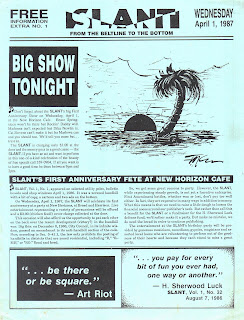Note: In an effort to be funny in an off-beat way, I wrote this piece in 2000. As it happened, the people quoted were told the scenario and then given the freedom to write their own lines, in character.
It was a lot of fun brainstorming and assembling piece. It was first published by
Richmond.com. My thanks still goes out to the editor, Richard Foster, who had the nerve to run this difficult-to-categorize story.
Though cynical people like to say, “All cats are gray in the dark,” the difference between this and that counts with me. Thus, if for no other purpose than to satisfy my own curiosity, I set out to find the truth about Gus, the gray and white cat that had long presided over lower Carytown from his plush basket in a bookstore display window facing the street.
 |
This
photo of Gus was shot by
Stacy
Warner for Richmond.com.
|
Since I’ve known Salins, a writer/filmmaker/house-painter, for a long time, I suspected his charge was a setup for a weak joke. To give him room to operate I asked, “So, this Gus is an impostor?”
“Just like Lassie, several cats have played the role of Gus over the years,” Salins said matter-of-factly.
Until that moment it hadn’t occurred to me that Gus, someone else’s cat, had slowly become important to me over the years. In the past I’ve been told that he’s over 15, maybe pushing 20. Who can say what that is in cat years? He still has a few teeth left.
“You see, in ‘91, I had lost my beloved Skinkywinkydinky in a separation,” Salins continued, as if he was revealing a dark conspiracy. “When I first saw Gus, I took to him, because he reminded me of Skinky. That Gus wouldn't let you touch him. But, this Gus…”
“Ted, this is absolutely the most off-the-wall nonsense you’ve come up with yet,” I accused.
“The place has changed hands a few times since then,” Salins smugly offered. “The problem is each owner falls in love with the cat and keeps it. But since Gus has become an institution in Carytown, each set of new owners has to find another cat that looks like Gus. The switch is made at night in order to preserve the secret. I’ve seen it.”
Before I could say “horsefeathers,” another member of the Carytown intelligentsia, who had just walked up, spoke: “Salins, as usual you’re all wet,” said artist Jay Bohannan. “That is not only the same cat, but Gus is, let’s see, yes, he’s nearly 70. That particular cat is probably the oldest cat this side of the island of Lamu.”
I laughed at Bohannan’s crack and excused myself from the table to let them hash it out. The two of them have been arguing good-naturedly since their VCU art school days in the early ‘70s.
Walking toward my car, Ted’s suggestion of a fraud having been perpetrated on the public bothered me. I felt certain that if somebody had actually installed a faux Gus in the bookstore it would have been all over the street the next day. As I tried to imagine people spiriting nearly identical cats in and out of the back door, in the dead of night, the matter wouldn’t rest.
So I turned around and went into Carytown Books. The shop’s manager, Kelly Justice, who has worked there for six years under three editions of ownership, scoffed at Salins’ charge.
“Anyone who knows Ted, knows he’s a nitwit,” said Ms. Justice with a wry smile. “More likely than not, this is an attempt to raise funds for another one of his documentaries.”
When I told her about Bohannan’s equally outrageous suggestion that Gus was almost a septuagenarian, Justice laughed out loud. “Perhaps Jay and Ted are both trying to hitch their wagons to Gus’ star,” she suggested playfully.
Back outside, Salins and Bohannan were both gone. So I walked east on the block to Bygones, the collectable clothing and memorabilia store known for its artful window displays. Since Maynee Cayton, the shop’s proprietor, is an unofficial historian for the neighborhood, I decided to see what she knew about Gus.
Cayton, who has been at that location for 16 years, said she had some pictures of the block from the ’30s and ‘40s, but she didn’t think she had any shots of a bookstore cat. However, she did remember that when she was a child she saw a gray and white cat in the window of what was then the Beacon Bookstore.
“It was in the late ’60s, I think it was 1967,” she said, raising an eyebrow. “And I’d say it was a young cat. Either way, I can’t believe the feline impersonator story, so maybe it was Gus.”
The next day, Bohannan called on the phone to tell me he had something I needed to see right away. He was mysterious about it and wouldn’t explain what he was talking about, except to say that it was proof of his claim about Gus the Cat.
Unable to let it go, I told him I’d stop by his place to see what proof he had.
Bohannan’s apartment, located between Carytown and the Virginia Museum of Fine Arts, was an escape from the modern world altogether. It’s furnished in a pleasant mix of practical artifacts and curiosities from yesteryear. The heavy black telephone on his desk was almost as old as Jay. Next to the desk was a turn-of-the-century gramophone. Bohannan, himself, dressed like a character who just stepped out of a Depression-era RKO film, reached into a dog-eared manila folder and pulled out a photograph. When I asked him where he had gotten the picture, purportedly from about 1930, he shrugged.
In such a setting, his evidence of Gus’ longevity took on an eerie authenticity. Sitting in one of Bohannan’s ancient oak chairs, surrounded by his own paintings of scenes from Virginia’s past, I thought I could see the cat he claimed was depicted in the storefront’s window. Why, it even looked like Gus.
Jay told me I could keep the photo, it was just a Xerox copy. What a scoop!
Later, when I looked at the grainy picture at home, I could hardly even see a cat. The next day, back in Carytown, I spoke with several people who hang out or work in the neighborhood. A few actually thought Bohannan’s bizarre contention could be true. Others agreed with Salins.
One man, who refused to be quoted with attribution, said he was sure the original Gus was an orange cat. A woman looked up from her crossword puzzle to note that Bohannan's evidence was at least as good as what she'd seen on the Loch Ness Monster.
Then the whole group of chatty know-it-alls went off on the general topic of conspiracy theories and hoaxes. At the next table a woman in a straw hat started sketching the sidewalk scene.
A few days later, I saw Ted Salins holding court in front of the coffee shop. I told him what Kelly had said about his claim and I showed him Jay’s so-called proof that Gus is ancient.
“The next thing you’re going to tell me is Shakespeare actually wrote all those plays," Ted said mockingly. "Look, it’s not the same cat. Live with it. This Gus is a ringer, maybe three years old.”
Turning around, I looked through the storefront’s glass at good old Gus in his usual spot. He looked comfortable with a new electric heater under the blanket in his basket. It dawned on me that there was a time when Gus used to avoid me, as well. Now he seems happy for me to pet him, briefly.
Pulled back into the spell of the mystery, I wondered, had Gus changed or had I? Gus stared back at me and blinked. Like one of his favorite authors, J. D. Salinger, Gus wasn’t talking.
Gus was smiling as only a cat can; a smile that suggests equal parts of wisdom-of-the-ages and dumb-as-a-bag-of-hammers. One obvious truth about Gus the Cat was that he had grown quite accustomed to having a public.
Note: On June 19, 2001 a cat alleged to have been the authentic Gus the Cat was found dead in Carytown Books; he was estimated by the bookstore's spokesperson to have been about 18 years old.




























